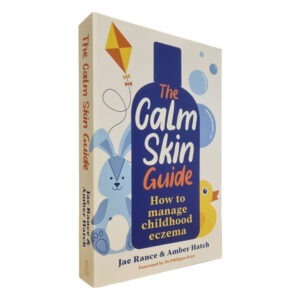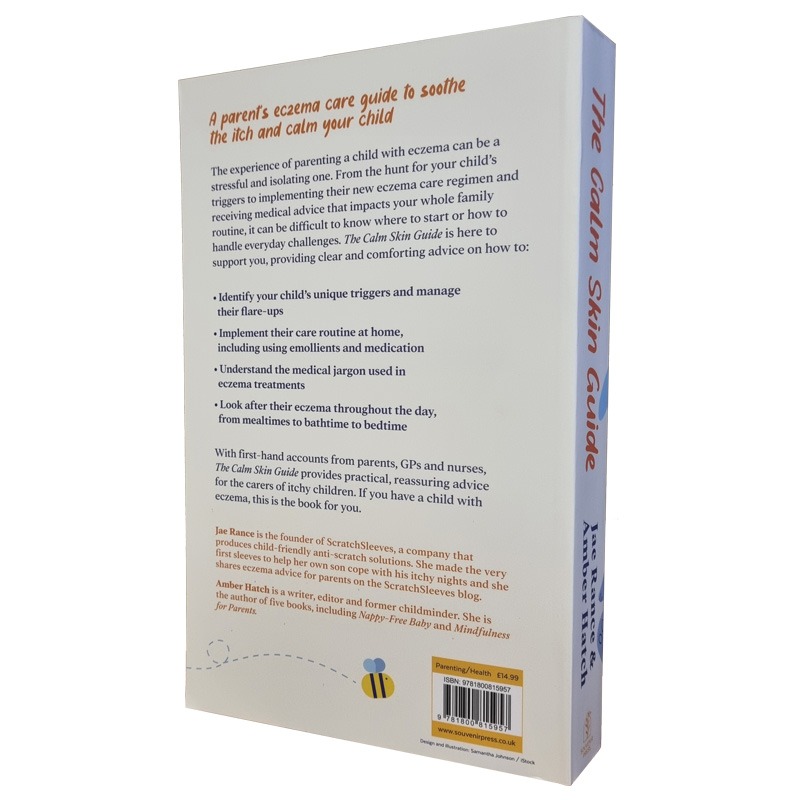Growing up with eczema: Milestones and life stages



Having a child with eczema lays another layer of complexity over parenthood. It can affect everything from whether one parent chooses to go back to work, to starting nursery or school. The vast majority of babies with eczema will grow out of it at some point, but it may well flare up again during puberty or at times of stress. We look at how childhood eczema can affect the milestones of growing up.
Changing patterns
Childhood eczema usually appears at around 3-4 months. Typically it first appears on the cheeks and scalp before spreading to the knees, elbows and trunk. Usually, the nappy area isn’t affected.
As children grow up, the eczema shifts. By around 18 months the main eczema patches are typically moving to the flexure points. Flexure points are the inner side of any part of the body that is regularly bending. Typically the inside of the elbows and backs of knees are worst affected. Wrists, ankles and the neck can also be troublesome. In older children, eczema around the eyes often points to airborne allergies (pollen or pet dander).

Teething and Eczema
Teething is a well known anecdotal trigger for flare-ups in pre-existing baby eczema. It’s not clear if the trigger for these flare-ups is the stress associated with teething, aggravation by the excess droll associated with teething, the hormones which triggered the teething in the first place, or a combination of the three.
If your baby’s eczema has a sudden flare-up it’s worth checking for the signs of a new tooth. The most common teething symptom is sore, red gums possibly with blue-grey blisters over the new tooth.
Teething tends to be accompanied by a lot of droll. This irritates the skin and makes skin infections more likely. Using a barrier cream like Vaseline over your baby’s chin and neck can reduce this.
Once your child’s teeth appear, you will need to clean them twice a day with baby toothpaste. Most toothpaste contain sodium laureth sulphate (SLS) which can aggravate eczema. We use Oranurse toothpaste, which is both SLS and flavour-free.
Remember that teething doesn’t stop with the appearance of the premolars. Five year molars and wisdom teeth as well as all the regular adult teeth can all cause flare-ups.
Starting nursery
Whether you are returning to work after maternity leave or you have other commitments requiring your attention – sending your child off to nursery can be anxiety inducing for anyone. Having a child with eczema can make this even more stressful.
Skin care at nursery
Most parents’ biggest worry about sending their child to nursery is maintaining their skin care regime. Because emollients can be classed as medication, this can be a tricky area to negotiate. Depending on your nursery’s medical policy, applying emollients may entail a lot of paperwork. Emollients may need to be supplied with the pharmacy label attached. Applications may need witnesses and multiple signatures. It’s important to talk to the nursery about these issues and find out what their individual policy is. That said, most nurseries will have come across other children with eczema previously and will have procedures in place.
Avoiding eczema triggers at nursery
Given the huge rise in food allergies over recent years, most nurseries have robust controls to ensure that they can safely cater for children with food allergies. However, there are plenty of other possible eczema triggers within the nursery setting that you will need to consider.
- Temperature. If you’ve visited a nursery recently you will know just how warm they are. And that most nurseries use their outside space a lot. Warmth and sudden change in temperature are both common eczema triggers. You’ll need to think about how best to dress your little one.
- Hand washing. Hand washing is encouraged at nurseries for obvious reasons. Repeated handwashing alone can dry the skin. In our experience, sudden flare-ups on our itchy boy’s hands were inevitably linked to a change in the hand soap.
- Laundry detergents. Some nurseries provide bedding for nap time but this (and the dress-up clothes) may be washed in detergents that irritate your child’s skin. If you know that detergents are a problem for your child you’ll need to discuss this with the staff.
- Sensory play. Sensory play is key in childhood development. Play trays are likely to be stocked with soaps, paints, sand, coloured water and salty playdough (especially drying on little hands). Another thing to discuss with the staff.
- Sunscreen. Most nurseries provide sunscreen but if your little one is sensitive to them you will need to provide your own. Ask staff to apply your child’s cream first to avoid cross-contamination.
The social benefits of going to nursery are immense. You will need to balance the risks of an eczema flare-up against the benefits. In all probability you will see a flare-up in the first few days. Step up your emollient regime for the few days before your little one starts to head it off at the pass.
Starting school
Just like starting nursery, when your child starts school you will need to talk to the staff. If your child has moderate-to-severe eczema and/or associated allergies, they may need an individual healthcare plan. This will clarify what needs to be done, when and by whom. If your child’s eczema is less severe but still troublesome, it will be a more informal discussion.
Things to include in these discussions include:
- School uniform. Is it possible to switch the itchy acrylic jumper for a cotton one in the same colour? Are polo shirts without the scratchy stitched logo acceptable?
- Temperature. Like nurseries, classrooms are often quite hot, is it possible to seat your child away from the radiator?
- Emollients. Is there somewhere suitable for your child to apply their creams? Will there be some available to help them?
- Circle time. Will your child be sitting on a carpet? If this is irritating their skin, can they sit on a cushion?
- Tiredness. Broken nights can make it difficult to concentrate in class. Can the school accommodate this?
- Other children. Your child’s classmates will inevitably raise questions about your child’s skin. Is it possible for the school to address this with the whole class, perhaps as a circle time topic?
You can find out more about starting school with eczema here.
Helping your child take control of their eczema
Before your child starts school it can be really helpful to get them more involved in their skincare routine. This is especially true if they will need to apply emollient during the school day. Schools are busy places and there may not always be an adult available to help them.
For young children, start with identifying the different parts of their body where their eczema occurs. This will help them to recognise their symptoms. Talk to them about the treatments you are providing and why. The next step is helping them to apply cream to the easy to reach places. Arms, legs and belly are a really good place to start. Explain how much cream to use and how to smear it on in the same direction as their hair grows.
As soon as they are able, allow them to talk to their healthcare providers directly. Resist the temptation to talk for your child. Instead prompt them to repeat things that they have previously told you. Not only is it important that your child is able to articulate how the eczema affects them, it also reduces the chances of their description getting lost in translation. Talking to medical professionals will also develop their understanding and confidence in dealing with their condition.
Being familiar with their symptoms and treatment will make the transition to school easier. That confidence will be be invaluable when answering questions from classmates reducing the chances of mean comments. Don’t worry too much, primary school children are typically remarkably inclusive and tolerant of differences, despite being very inquisitive. You can read about this more here.
Growing out of eczema
Not so long ago, the received wisdom was that childhood eczema would disappear (or resolve) before adulthood. However, eczema sufferers the world over knew that this wasn’t actually the case. Recent studies have confirmed that although eczema can, and often does, resolve in later childhood, it will sometimes persist throughout life.
A large meta-study, which incorporated the information about over 110,000 children with eczema, found that 80% of children grew out of their eczema by the time they were 8 years old. Only 5% cases persisted beyond 18 years1.
Eczema is driven by a complex interplay of genetic and environmental factors. There is no one single factor that will accurately predict eczema persistence. However, there are some common trends. The biggest risk factors for persistent eczema is a family history of atopic disease (eczema, asthma or hay fever) and darker skin tones. Find out more here.
Teenage Skin
It’s not uncommon for previously dormant eczema to flare up during puberty. There’s no clear reason for this, but it is usually put down to a combination of teenage hormones and stress. It’s also possible the experimentation with different toiletries and fragrances, coupled with aggressive acne treatments could also be contributing. If your teen’s eczema has suddenly flared up again, a quick audit of their current toiletries and update of their skincare routine may well solve the problem.
Our references
This is the round-up article for our Eczema Life Stage and Milestones topic. You can find more articles by following the links in the text or by scrolling through the articles below.
Here at ScratchSleeves, we don’t just share our experiences of bringing up an eczema child and favourite allergy-friendly recipes. We also manufacture and sell our unique stay-on scratch mitts and PJs for itchy babies, toddlers and children. We now stock sizes from 0-adult years in a range of colours. Visit www.scratchsleeves.co.uk to see our range of eczema friendly clothing for babies, children and adults.
The Calm Skin Guide
Love our blog? It's also available in book format with:
- First hand accounts from parents & medical professionals
- Easy navigation
- Comprehensive index
- Additional material
Signed copies available at no extra cost
Written by:
Interesting article? Don't keep it to yourself...
Read next...
You may also find helpful...
Quick buy


Multi Buy Discount

Spend between £30 - £60 and save 5%
Spend between £60 - £120 and save 10%
Spend over £120 and save 15%
Discount automatically applied at checkout
No Quibbles Guarantee

ScratchSleeves abide by a no quibbles guarantee.
Free UK Postage

Free packing and postage on all UK orders. For overseas orders to Europe postage is from £3.50, to USA is £6.50 and to the rest of the world, from £3.75.






